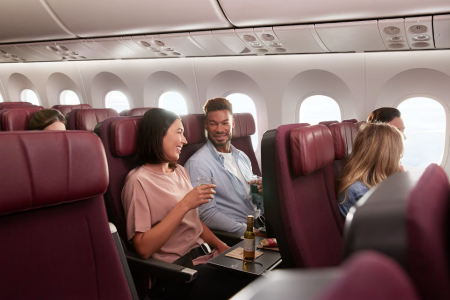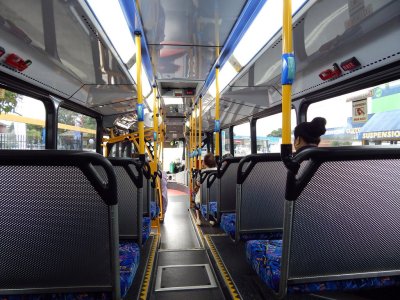Australian airlines faced with new problems as plane seats ‘shrink’
By
VanessaC
- Replies 17
Travelling can be a hassle, especially when you’re deeply concerned about your safety and wellbeing.
Now, here’s something to add to your list of worries—airline seats that are getting too small for the average Australian.
New research with 20,000 adult participants done by the University of South Australia, Transport for NSW, and Victoria's Transport Department showed that the average Australian gains up to 3kg each decade, while seat dimensions on aeroplanes have remained stagnant.
Ian Christensen, Managing Director of iMOVE Cooperative Research Centre that produced the nation’s first anthropometry data, called the weight gain statistics 'alarming'.
'It's alarming because of the implications it has for our transport vehicles and potentially alarming for the impact that it might have on community health,' Christensen said.
Moreover, the study showed that additional weight may be an issue for travellers as 'changes in body shape dimensions over the past 30 years have rendered airline seating dimensions to be problematic and unable to accommodate up to 68 per cent of males and 22 per cent of females'.
According to Christensen, Airlines base their average passenger weight data on decades-old averages that no longer reflect the current reality of the Australian population. This poses 'significant problems for people in the Australian community who are at the high end of the spectrum in terms of either weight or height'.
'It would be prudent for all transport authorities, public and private, to make sure that the vehicles that they're adding to their fleet are designed to accommodate the community that actually exists and the people that actually exist, not some imagined average that is not accurately reflecting the current population,' Christensen added.
This issue is not unique to Australia, as the whole world faces the possibility of having more than half of its population overweight or obese by 2035.
Known American plus-size traveller Jae'lynn Chaney started a petition in April urging aviation authorities in the US to require airlines to give an extra seat to those who need them—free of charge!
'Is it right to squeeze someone into a single seat, causing discomfort for them and their fellow passengers, when a simple solution exists?' Chaney said.
'We're not asking for luxury; we're asking for basic dignity.'
You can read more about Chaney’s initiative here.
Local airlines Virgin and Qantas declined to comment when they were asked about their plans for future seat designs in consideration of the new statistics that were released.
The only accommodations being offered to plus-size travellers now are the ability to purchase an extra seat next to their seat and seatbelt extensions.
The problem also affects other modes of transportation, such as public buses and trains.
According to Senior Human Factors Specialist Christina Kirsch, Transport for NSW will be considering the new statistics in their future planning for public modes of transport.
'Our objective is to gain data specific to the Australian population so we can design public transport that caters specifically to our shapes and sizes,' Kirsch explained.
'These designs directly impact passenger comfort, safety, accessibility, and overall user experience.'
'By incorporating anthropometric data into the design process, we can ensure that work and transport systems are more efficient, safe, and comfortable to use by our staff and customers.'
 Members, what are your thoughts on this latest study? Let us know in the comments below!
Members, what are your thoughts on this latest study? Let us know in the comments below!
Now, here’s something to add to your list of worries—airline seats that are getting too small for the average Australian.
New research with 20,000 adult participants done by the University of South Australia, Transport for NSW, and Victoria's Transport Department showed that the average Australian gains up to 3kg each decade, while seat dimensions on aeroplanes have remained stagnant.
Ian Christensen, Managing Director of iMOVE Cooperative Research Centre that produced the nation’s first anthropometry data, called the weight gain statistics 'alarming'.
'It's alarming because of the implications it has for our transport vehicles and potentially alarming for the impact that it might have on community health,' Christensen said.
Moreover, the study showed that additional weight may be an issue for travellers as 'changes in body shape dimensions over the past 30 years have rendered airline seating dimensions to be problematic and unable to accommodate up to 68 per cent of males and 22 per cent of females'.
According to Christensen, Airlines base their average passenger weight data on decades-old averages that no longer reflect the current reality of the Australian population. This poses 'significant problems for people in the Australian community who are at the high end of the spectrum in terms of either weight or height'.
'It would be prudent for all transport authorities, public and private, to make sure that the vehicles that they're adding to their fleet are designed to accommodate the community that actually exists and the people that actually exist, not some imagined average that is not accurately reflecting the current population,' Christensen added.
This issue is not unique to Australia, as the whole world faces the possibility of having more than half of its population overweight or obese by 2035.
Known American plus-size traveller Jae'lynn Chaney started a petition in April urging aviation authorities in the US to require airlines to give an extra seat to those who need them—free of charge!
'Is it right to squeeze someone into a single seat, causing discomfort for them and their fellow passengers, when a simple solution exists?' Chaney said.
'We're not asking for luxury; we're asking for basic dignity.'
You can read more about Chaney’s initiative here.
Local airlines Virgin and Qantas declined to comment when they were asked about their plans for future seat designs in consideration of the new statistics that were released.
The only accommodations being offered to plus-size travellers now are the ability to purchase an extra seat next to their seat and seatbelt extensions.
The problem also affects other modes of transportation, such as public buses and trains.
According to Senior Human Factors Specialist Christina Kirsch, Transport for NSW will be considering the new statistics in their future planning for public modes of transport.
'Our objective is to gain data specific to the Australian population so we can design public transport that caters specifically to our shapes and sizes,' Kirsch explained.
'These designs directly impact passenger comfort, safety, accessibility, and overall user experience.'
'By incorporating anthropometric data into the design process, we can ensure that work and transport systems are more efficient, safe, and comfortable to use by our staff and customers.'
Key Takeaways
- A new study showed the average Australian gains 3kg every decade, which may affect their travel experiences.
- The study states that airlines and transport authorities need to rethink their seating strategies, as the current seating dimensions may not be able to accommodate up to 68 per cent of male and 22 per cent of female travellers.
- Ian Christensen, the Managing Director of iMOVE Cooperative Research Centre, believes transport vehicles need to adapt to the existing population's physical reality, not on decades-old averages.
- The issue extends beyond airlines to other forms of transport, such as public buses and trains, indicating the need for wider changes in transport design to accommodate changing body sizes.









